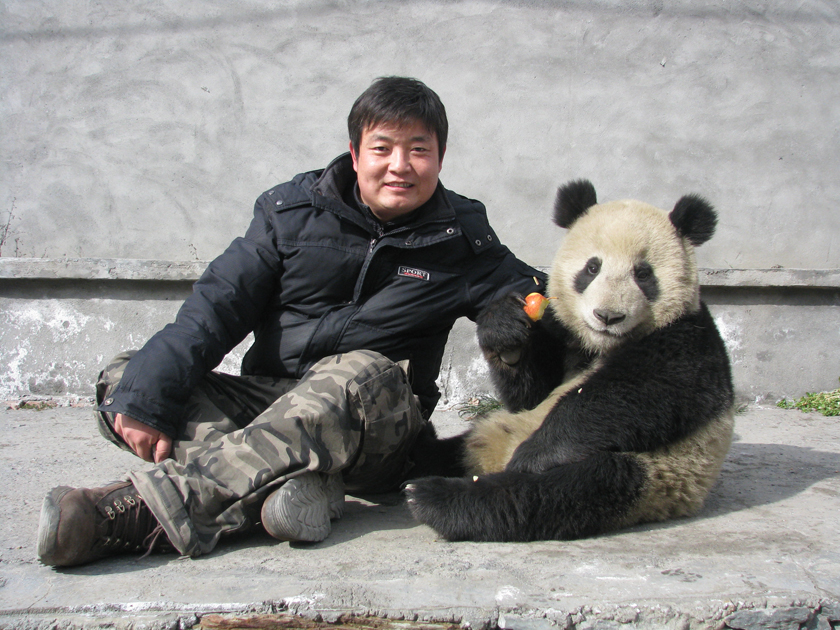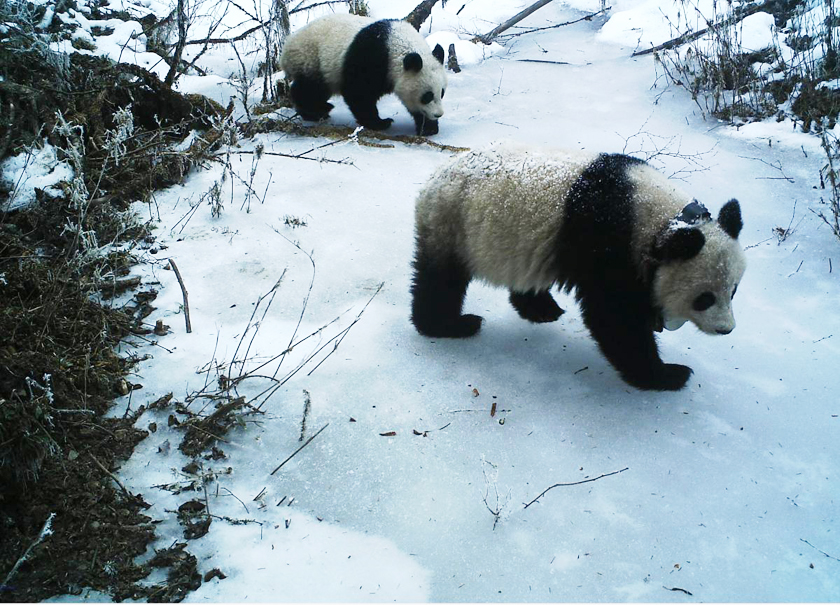Pandas Don’t Play By The Rules
A new study indicates that the activity patterns of the midnight snackers are different from that of most other mammals.
By Vicki Croke
Jindong Zhang, a research associate at Michigan State University, with a young panda at the Wolong Nature Reserve. Reams of GPS collar data yielded surprises about the activity patterns of these unique animals. Photo: Kurt Stepnitz/MSU.
You’ve got to admire giant pandas, and for a lot more than their beauty. One of their best qualities is that they dodge expectation.
They’ve been able to confound preconceptions about them for centuries. Even over the last decades, modern scientists have struggled to unlock many of their secrets. The latest puzzle to be revealed shows once again how unlike most other animals they are.
This time it’s their body clocks holding a surprise. The results of a study led by scientists at Michigan State University (MSU) and featured in this month’s Journal of Mammalogy indicate that the peak activity patterns of giant pandas are different from those of other mammals.
Wild giant pandas, it seems, have three periods of activity—morning, afternoon, and—get this—“around midnight.†That’s different from the three more established patterns of movement seen with most other mammals: Nocturnal—active at night, diurnal—active during the day, and crepuscular—active at dawn and dusk.
A panda at the Wolong Nature Reserve in southwestern China. Pandas do have some adaptations for eating bamboo—such as these thumb-like wrist bones. But, still, they are basically carnivores with the diet of an herbivore. Photo: Kurt Stepnitz/MSU.
Researcher Vanessa Hull explains that previous studies on pandas from years ago, using more old-fashioned telemetry, pointed toward two activity peaks per day for giant pandas—fitting something more traditional, like a crepuscular lifestyle. But this new research, using GPS collars that downloaded data every five minutes around the clock, was much more accurate, and yielded a surprise. “It was sort of unexpected for us,†she says, “because in the past pandas had shown two activity peaks at dusk and dawn, so we weren’t expecting to see this sort of unique pattern.â€
In a statement from MSU, research associate Jindong Zhang said, “We cannot simply say the panda is a crepuscular creature. Giant pandas show complex activity patterns that are closely related to food quality and water availability,†Zhang said. “They need to eat food more frequently, such as at midnight, since the nutrition quality of bamboo is low. The study of the activity patterns of pandas opens a door to discovering the unique adaptations of pandas to their environment.â€
“They sit down in a bamboo patch and eat their way out of it. When they’ve eaten all the bamboo that’s available there, they get up and move on to the next place.†–Researcher Vanessa Hull.
The study group collared and tracked five giant pandas—four females and one male—in China’s famous Wolong Nature Reserve over a two-year period between 2010 and 2012. After a ban on the use of GPS collars for wild pandas for more than ten years, this is one of the first study groups allowed by the government to use them again. (The group included scientists from the China Conservation and Research Center for the Giant Panda in Wolong, and the Chinese Academy of Sciences.)
Mei-Mei, one of the collared pandas from the study, with her cub. When her activity pattern slowed way down, the researchers were at first concerned, and then realized she was pregnant. Photo: Vanessa Hull.
The researchers see the odd activity pattern as an important part of the panda’s strange lifestyle. Aside from a few nuanced adaptations (some specialized teeth, and that famous thumb-like wrist bone), a giant panda is basically a carnivore with the diet of an herbivore. Bamboo-eating pandas digest about 17 percent of what they consume. Unlike cows, for instance, they don’t have the plumbing to batter tough plant cell walls to get at the nutrients. Animals who eat what they are built to eat—lions, for instance—can absorb something like 80 to 90 percent of what they consume.
So concentrating on a menu made up almost exclusively on bamboo is a perplexing choice for a bear, though one that scientists guess was made because it is a food source that is plentiful and available year round. “Nearly every inch†of panda habitat seems filled with bamboo, Hull says.
Still, the trade-off is that pandas have to eat constantly. Hull says, they “sit down in a bamboo patch and eat their way out of it. When they’ve eaten all the bamboo that’s available there, they get up and move on to the next place.†She says the activity peaks most likely come after they’ve eaten and rested. Then “there’s sort of a burst of energy to go fill up their stomachs again.â€
A napping panda at the Wolong Nature Reserve in southwestern China. Photo: Kurt Stepnitz/MSU.
Pandas don’t fit into categories easily. They were classified for a time as raccoons before DNA studies definitively restored them to the bear family. And though they have the diet of an herbivore, they don’t resemble one and they don’t share the same concerns as one.
“Many herbivores have a kind of crepuscular foraging strategy because they want to avoid predators and/or humans that are usually active during the day, so they eat as much as they can at dawn and dusk,†Hull said in a statement. “But with pandas, they don’t have any major predators, so they can afford to adjust their activity patterns to their own schedule and not worry about running into something that would eat them. It is just interesting to see that they take advantage of this.â€
The researchers haven’t coined a name for this novel kind of activity pattern. Hull laughs when I ask her about it and says, “We haven’t yet…but we’re open to suggestions!†She does hope that the information her team has gathered on five individuals can be applied more broadly to all pandas. “The story of doing research on pandas is that way,†Hull says, “There’s so much we don’t know. So much we’re still finding out.â€
As wonderful as it is to discover more and more about this enigmatic species, it’s also fun to know that they keep their secrets.
As I wrote in my 2005 book “The Lady and the Panda,†which was about Ruth Harkness, the woman who brought the first live giant panda to the United States in 1936 (and who would go on to fight for their conservation):
It looked to one zoologist of the time as though pandas simply had “little interest in evolution.†These magnificent animals seemed so impractical, in what they eat, in the way they mate, and even in their flashy coloring. And yet whatever they’ve done has worked. They have roamed this planet far longer than man. It is the mystery of the giant pandas—they have survived over millions of years even when other, seemingly more fit species have not.
So much about the panda has seemed so paradoxical that the animal appears the embodiment of yin and yang. Somehow the bear with a tenuous grasp on existence has lived longer than humankind, the animal built to be a carnivore lives as an herbivore, and the solitary creature so adept at hiding from the world displays the most colorful of markings.
To Ruth Harkness, there was an appealing integrity in the panda’s existence. “They had lived through a world with such changes as we have never seen, and they had remained themselves,†she wrote.





